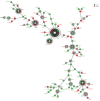Changing Epidemiology of Presumptive Community-associated-methicillin-resistant Staphylococcus Aureus in Slovenia in 2014-2015 Compared To 2010
- PMID: 33133280
- PMCID: PMC7583430
- DOI: 10.2478/sjph-2020-0030
Changing Epidemiology of Presumptive Community-associated-methicillin-resistant Staphylococcus Aureus in Slovenia in 2014-2015 Compared To 2010
Abstract
Introduction: Although the distinction between the Community-Associated-Methicillin-Resistant Staphylococcus aureus (CA-MRSA) and Hospital-Associated-Methicillin-Resistant S. aureus (HA-MRSA) has blurred in recent years, the CA-MRSA is an important group because of its potential to cause fulminant and severe infections. Its importance has further increased with the emergence of Livestock-Associated-Methicillin-Resistant S. aureus (LA-MRSA).
Methods: In the present study we analysed clonal distributions and virulence factors in presumptive CA-MRSA isolated from January 2014 to December 2015 and compared the results with our previous study from 2010. Phenotypic definition for presumptive CA-MRSA was based on resistance to cefoxitin and oxacillin and susceptibility to at least two of the following four antibiotics: ciprofloxacin, erythromycin, clindamycin and gentamicin.
Results: In 2014 and 2015 altogether 304 MRSA isolates fulfilled our screening phenotypic definition, 45 isolates were cultivated from clinical specimens and 259 from screening specimens. Sequence types ST398, LA-MRSA and mecC MRSA increased significantly in 2015 compared to 2010 (p-value <0.05) and were spread over Slovenia.
Conclusion: The clonal distribution of presumptive CA-MRSA has changed within the study period in Slovenia. In 2015 the most frequent clone among clinical and screening specimens was a pig-associated clone, ST398, but the number of confirmed ST398 infections remains low. While previously ST398 and mecC positive MRSA strains were geographically limited, they have spread throughout the country since 2010.
Uvod: Čeprav je ločevanje med proti meticilinu odporno Staphylococcus aureus domačega okolja (CA-MRSA) in proti meticilinu odporno Staphylococcus aureus bolnišničnega okolja (HA-MRSA) oteženo, je v zadnjih letih CA-MRSA pomembna skupina, ki povzroča resne in ogrožajoče okužbe. Njen pomen se je povečal še s pojavom proti meticilinu odpornim Staphylococcus aureus rejnih živali (LA-MRSA).
Metode: V tej raziskavi smo analizirali zastopanost klonov in prisotnost virulenčnih dejavnikov pri sevih, sumljivih za CA-MRSA, ki so bili osamljeni od januarja 2014 do decembra 2015, in rezultate primerjali s študijo iz leta 2010. Fenotipska definicija za sumljive CA-MRSA je temeljila na odpornosti proti cefoksitinu in oksacilinu ter občutljivosti za vsaj dva od naslednjih štirih antibiotikov: ciprofloksacin, eritromicin, klindamicin in gentamicin.
Rezultati: V letih 2014 in 2015 je skupno 304 izolatov MRSA ustrezalo naši fenotipski definiciji. 45 izolatov je bilo osamljenih iz kliničnih kužnin, 259 iz nadzornih kužnin. Sekvenčni tip ST398, LA-MRSA in mecC MRSA, sta se v letu 2015 v primerjavi z letom 2010 signifikantno povečala (p-vrednost <0,05) in se razširila po Sloveniji.
Zaključki: Zastopanost klonov pri sevih, sumljivih za CA-MRSA, se je v obdobju raziskave v Sloveniji spremenila. V letu 2015 je bil najpogostejši klon med kliničnimi in nadzornimi kužninami klon ST398, MRSA rejnih živali, vendar je število potrjenih okužb s ST398 še vedno nizko. V letu 2010 so bili ST398 in mecC pozitivni sevi MRSA geografsko omejeni, v kasnejših letih pa so se razširili po vsej državi.
Keywords: CA-MRSA; LA-MRSA; Slovenia; clones; mecC; spa types.
© 2020 Urška Dermota, Irena Grmek Košnik, Sandra Janežič, Maja Rupnik, published by Sciendo.
Conflict of interest statement
Conflict of interest The authors declare that no conflicts of interest exist in relation to this research.
Figures
Similar articles
-
Survey of community-associated-methicillin-Resistant Staphylococcus aureus in Slovenia: identification of community-associated and livestock-associated clones.Int J Med Microbiol. 2015 Sep;305(6):505-10. doi: 10.1016/j.ijmm.2015.05.002. Epub 2015 May 27. Int J Med Microbiol. 2015. PMID: 26055648
-
Molecular epidemiology of community-associated methicillin-resistant Staphylococcus aureus in Spain: 2004-12.J Antimicrob Chemother. 2014 Nov;69(11):2913-9. doi: 10.1093/jac/dku232. Epub 2014 Jul 1. J Antimicrob Chemother. 2014. PMID: 24990868
-
Local and Transboundary Transmissions of Methicillin-Resistant Staphylococcus aureus Sequence Type 398 through Pig Trading.Appl Environ Microbiol. 2020 Jun 17;86(13):e00430-20. doi: 10.1128/AEM.00430-20. Print 2020 Jun 17. Appl Environ Microbiol. 2020. PMID: 32358001 Free PMC article.
-
Methicillin resistance in Staphylococcus isolates: the "mec alphabet" with specific consideration of mecC, a mec homolog associated with zoonotic S. aureus lineages.Int J Med Microbiol. 2014 Oct;304(7):794-804. doi: 10.1016/j.ijmm.2014.06.007. Epub 2014 Jun 28. Int J Med Microbiol. 2014. PMID: 25034857 Review.
-
MRSA in Humans, Pets and Livestock in Portugal: Where We Came from and Where We Are Going.Pathogens. 2022 Sep 27;11(10):1110. doi: 10.3390/pathogens11101110. Pathogens. 2022. PMID: 36297167 Free PMC article. Review.
Cited by
-
Association of Common Zoonotic Pathogens With Concentrated Animal Feeding Operations.Front Microbiol. 2022 Jan 10;12:810142. doi: 10.3389/fmicb.2021.810142. eCollection 2021. Front Microbiol. 2022. PMID: 35082774 Free PMC article. Review.
-
Whole genome sequencing and molecular epidemiology of methicillin-resistant Staphylococcus aureus isolated from patients with bacteraemia in Slovenia.Eur J Clin Microbiol Infect Dis. 2024 May;43(5):969-977. doi: 10.1007/s10096-024-04802-1. Epub 2024 Mar 22. Eur J Clin Microbiol Infect Dis. 2024. PMID: 38517572 Free PMC article.
-
Different sampling strategies for optimal detection of the overall genetic diversity of methicillin-resistant Staphylococcus aureus.Microbiol Spectr. 2024 Jul 2;12(7):e0014024. doi: 10.1128/spectrum.00140-24. Epub 2024 May 29. Microbiol Spectr. 2024. PMID: 38809050 Free PMC article.
References
-
- Bal AM, Coombs GW, Holden MTG, Lindsay JA, Nimmo GR, Tattevin P. Genomic insights into the emergence and spread of international clones of healthcare-, community- and livestock-associated meticillin-resistant Staphylococcus aureus: blurring of the traditional definitions. J Glob Antimicrob Resist. 2016;6:95–101. doi: 10.1016/j.jgar.2016.04.004. et al. - DOI - PubMed
LinkOut - more resources
Full Text Sources



